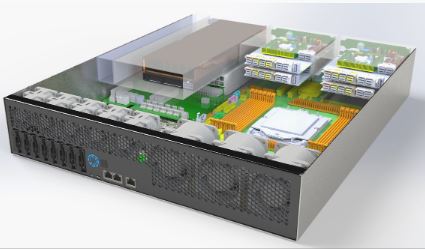
By: Jaan Mannik – Director of Commercial Sales
The term AI, or Artificial Intelligence, is everywhere nowadays and has quietly woven itself into the fabric of our daily lives. It powers the recommendations we see on streaming platforms, the navigation apps that guide us through traffic, and even the virtual assistants that answer our questions in seconds. From optimizing energy use in smart homes to predicting market shifts in finance, AI has become the invisible engine driving convenience, efficiency, and insight across industries.
In manufacturing, AI-driven robots collaborate with humans to streamline production. In agriculture, machine learning models monitor crops, forecast yields, and conserve resources. Retailers use predictive analytics to anticipate consumer needs before customers even express them. The reach of AI is no longer confined to futuristic labs, it’s in our phones, vehicles, and cities, constantly learning and adapting to serve us better.

OSS PCIe-based products deliver critical advantages for modern military sensor systems by enabling real-time data acquisition, processing, and transmission in rugged, mission-critical environments. These benefits stem from their ability to support high-bandwidth, low-latency interconnects, modular scalability, and environmental resilience, all of which are essential for today’s advanced military platforms.

Companies today are being asked to do more with data than ever before. Bigger AI models, faster insights, and workloads that don’t stay in one place, it’s a lot to keep up with. Traditional infrastructure just isn’t built for this kind of speed and flexibility.
The answer isn’t about throwing more hardware at the problem. It’s about building smarter, more agile infrastructure that adapts as demands change. And that’s where scale-out and increasingly, a blend of scale-out and scale-up come into play.

The rugged edge computing landscape is becoming increasingly complex with new generations of technologies, such as the latest AI focused GPUs, releasing annually rather than every 2-3 years. Whether the end application is commercial or defense, rugged edge servers must not only deliver cutting-edge compute performance but also withstand extreme environmental conditions.

When the PCI-SIG formally added support for 675W add-in card devices in the PCI Express Card Electromechanical (CEM) specification in August 2023, NVIDIA’s most powerful CEM GPU, the NVIDIA H100 80GB had a maximum power consumption of 350W. While some devices were starting to push the limits of datacenter thermodynamics – high density systems of many 675W devices seemed like a distant reality. However, with power constraints uncapped and the need for higher performing GPUs skyrocketing, the industry quickly came out with devices taking full advantage of the new specification capability. NVIDIA quickly replaced the H100 80GB with the H100 NVL, increasing power density to 400W. While this small jump was manageable for existing installations, NVIDIA then dove all-in with the H200 NVL released in late 2024 at 600W. The rapid transition from 350W to 600W has put power and cooling technologies in the spotlight in a race to solve this next generation challenge.